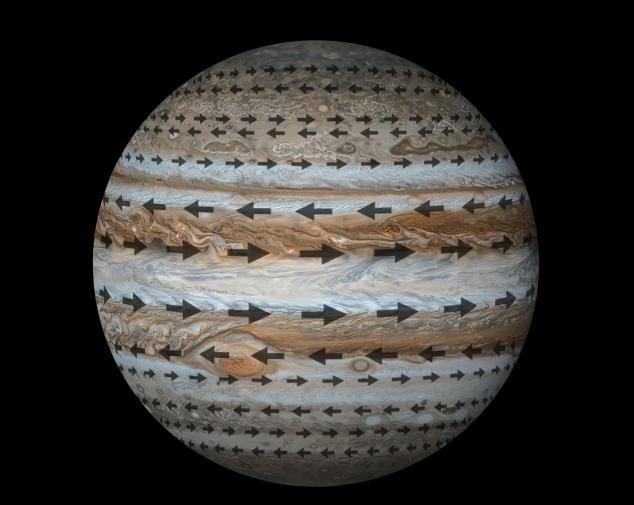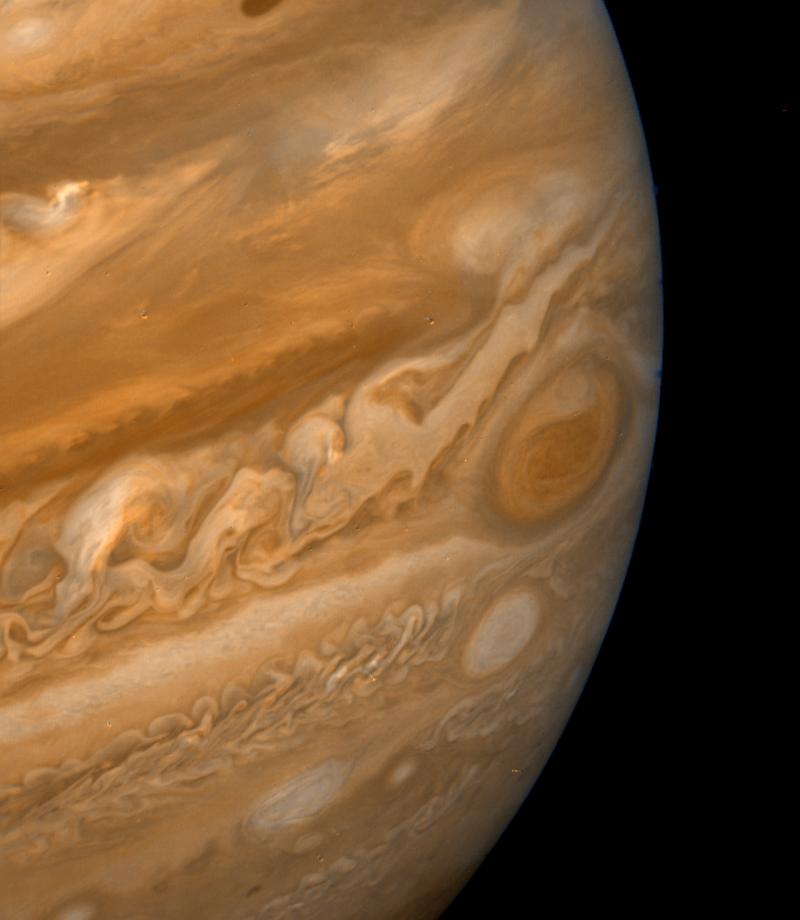Last updated on January 27th, 2024
54. Jupiter has an extremely strong and complex magnetic field that differs from that of the Earth, and is caused by the unusual structure of its diffuse core and the influence of the volcanic activity of its moon Io.
55. Jupiter’s magnetosphere (region affected by Jupiter’s magnetic field) extends 1,000,000 to 3,000,000 kilometres (600,000 to 2,000,000 miles) toward the Sun, which is 21 times the planet’s diameter. This immense magnetic field creates some spectacular aurorae at its poles.
56. Jupiter’s strong magnetic field attracts numerous asteroids and comets, experiencing about 200 times more impacts than Earth.
“One of Jupiter’s moon — Io — is the most volcanically active body in the solar system.”
57. Jupiter’s moons can be classified into regular and irregular satellites. The first 8 moons closest to Jupiter’s surface are regular, they have prograde and nearly circular orbits; while the rest are called irregular as they have prograde or retrograde eccentric orbits.
58. Jupiter’s irregular satellites with prograde orbits are given names ending with “a” or “o” (such as Pandia – Jupiter LXV), while irregular satellites with retrograde orbits have names ending in “e” (such as Eirene – Jupiter LVII).
59. Jupiter’s appearance with stripes and swirls is due to cold, windy clouds of ammonia and water that float in an atmosphere of hydrogen and helium. Jupiter has three distinct cloud layers: the innermost is made of water ice and vapour, the middle of ammonium hydrosulfide crystals, and the outer layer of ammonia ice.

60. The lines on Jupiter’s surface are generated by the planet’s quick rotation speed, which stretches the clouds into belts.
61. The colours observed on Jupiter’s surface may be due to plumes of gases containing elements such as sulphur or phosphorous that rise from the planet’s interior and react when exposed to ultraviolet light from the Sun.
62. The bands on Jupiter’s surface alternate in colour: the light ones are called zones, and the dark ones are called belts. Zones are colder than belts, and are regions of upwelling gas, while belts are regions of descending gas.
63. The Juno mission observed lightning flashes from electrical storms. The water clouds are assumed to generate thunderstorms similar to those observed on Earth; however, these discharges carry “mushballs” of water-ammonia slushes covered in ice.
64. Jupiter has numerous vortices at cloud level that can be distinguished due to the patterns generated by the surrounding clouds. The two largest ones are located in the southern hemisphere and are called Great Red Spot and Oval BA.
65. Astronomers study the vortices and their dynamics by using images collected throughout the years from the different probes sent to Jupiter. Smaller vortices are usually white, while larger ones are usually red. This variation in colour may be due to differences in speed and strength.
66. Depending on their size, the vortices on Jupiter’s surface last from several days to hundreds of years. Some storms fuse over time and originate larger ovals that are white or red, or even change colour over time.
67. Jupiter’s cyclones are warmer on top, with lower atmospheric densities, and colder at the bottom, with higher densities. Anticyclones (which rotate in the opposite direction) are colder on top and warmer at the bottom.

68. The characteristic Great Red Spot on Jupiter’s surface is a large anticyclonic vortex, the biggest storm in the Solar System, and its origin is unknown.
69. Great Red Spot rotates counterclockwise, completing a full rotation in 4.5 Earth days.
70. The anticyclonic storm that forms Great Red Spot seems stable, but the vortex is shrinking. In its first observations in the late 1800s it was approximately 41,000 kilometres (25,500 miles) across, in 1979 the Voyager 1 spacecraft measured it as 23,300 kilometres (14,500 miles), observations done in 2015 by the Hubble telescope measured it as 20,950 kilometres (13,020 miles), and measurements in 2017 state that it is now only 16,350 kilometers (10,160 miles) wide which is still 1.3 times the equatorial diameter of Earth.
71. Jupiter’s Great Red Spot extends 500 kilometres (300 miles) below the clouds.
72. The winds on the edges of Great Red Spot have a speed between 430 and 680 km/h (270 and 425 mph).
73. The second largest vortex on Jupiter’s surface, which is half the size of Great Red Spot, is called Oval BA, and originated in the year 2000 after the fusion of three smaller white storms. As well as Great Red Spot, it is an anticyclonic storm.
74. Although originally white, Oval BA started turning red in 2005, acquiring an appearance similar to Great Red Spot. That is why a NASA writer suggested that it should be called Red Spot Jr. or Red Jr.
75. The anticyclonic storm that forms Oval BA is 8,000 km (4,971 miles) wide, which is almost as wide as the Earth.
76. The wind speed on the edges of Oval BA reaches 396 km/h (246 mph).
77. Besides Great Red Spot and Oval BA, another peculiar trait on Jupiter’s surface is its circumpolar cyclones, which were discovered by the Juno mission. The northern pole has 8 cyclones moving around a central one (9 in total), and the southern pole has 5 big cyclones and a smaller one around a central one (7 in total). The northern cyclones are smaller than the southern ones.
78. Jupiter’s mean surface temperature is -110 °C (-166 °F). Calculations based on data collected by probes over the years, estimate that the temperature in the core is 19,700 °C (35,500 °F) where the pressure is 4,000 GPa.
79. In the intermediate region, where the temperature is between 4,730 and 8,130 °C (8,540–14,660 °F) and the pressure is 50–400 GPa, the hydrogen changes state from gas to liquid, creating the largest ocean in the Solar System.
80. Jupiter’s magnetosphere generates permanent aurorae around both poles, with variable intensity from day to day. They are caused by electrically charged particles originated in Io that are magnetically trapped by Jupiter and rotate with it.
81. Jupiter has faint rings that are only visible when backlit by the Sun. They were discovered in 1979 by the spacecraft Voyager 1, and are made of small dark particles.
82. The rings system in Jupiter has four main components: an inner torus of particles or halo ring, a brighter and thin main ring whose orbit coincides with that of the moon Adrastea, and two outer gossamer rings made of particles from the two inner moons Amalthea and Thebe, and connected to their orbits.
83. There is no possibility of life on Jupiter, even though it has some elements that were present in the primitive Earth (i.e., those which originated organic matter). This is because the high temperature and pressure make life impossible.
84. The first close-up images of Jupiter were obtained by spacecrafts of the Pioneer missions, which started in 1973. The latest images and data come from the Juno mission that arrived at the planet in 2016 and will continue performing flybys on Jupiter and its moons Io, Europa, and Ganymede until 2025.
Quick facts about Jupiter
| Date of Discovery | Unknown |
|---|---|
| Discovered by | Known by the Antients |
| Mean Orbit Velocity | 29,205 mph (0.438 x Earth) |
| Equatorial Radius | 43,440.7 miles |
| Equatorial Circumference | 272,945.9 miles |
| Volume | 343,382,767,518,322 cubic miles |
| Mass | 1,898,130,000,000,000,000,000,000,000 kg (317.828 x Earth) |
| Density | 1.326 g/cm cube (0.241 x Earth) |
| Surface Area | 23,713,907,537 square miles (120.414 x Earth) |
| Surface Gravity | 81.3 ft/s square |
| Escape Velocity | 134,664 mph |
| Atmospheric Constituents | Hydrogen, Helium and others |
| Rings | 4 |
| Effective temperature | -148 degree Celcius |
